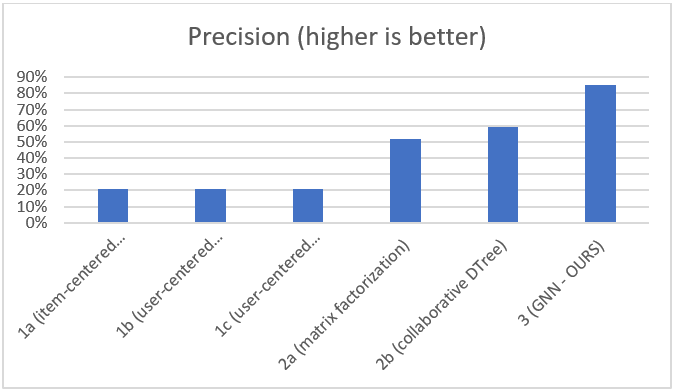Graph Neural Networks for E-Learning Recommendation Systems
Main Article Content
Abstract
This paper presents a novel recommendation system for e-learning platforms. Recent years have seen the emergence of graph neural networks (GNNs) for learning representations over graph-structured data. Due to their promising performance in semi-supervised learning over graphs and in recommendation systems, we employ them in e-learning platforms for user profiling and content profiling. Affinity graphs between users and learning resources are constructed in this study, and GNNs are employed to generate recommendations over these affinity graphs. In the context of e-learning, our proposed approach outperforms multiple different content-based and collaborative filtering baselines.
Article Details
References
R. Burke, A. Felfernig, and M. H. Göker,“Recommender systems: An overview,” Ai Magazine, vol. 32(3), pp. 13-18, 2011
M. J. Pazzani, and D. Billsus, “Content-based recommendation systems,” The adaptive web: methods and strategies of web personalization, pp. 325-341, 2007
G. Linden, B. Smith, and J. York, “Amazon. com recommendations: Item-to-item collaborative filtering,” IEEE Internet computing, vol. 7, no. 1, pp. 76-80, 2003
A. S. Das, M. Datar, A. Garg, andS. Rajaram,“Google news personalization: scalable online collaborative filtering,” In Proceedings of the 16th international conference on World Wide Web (pp. 271-280), 2007
C. A. Gomez-Uribe, and N. Hunt, “The netflix recommender system: Algorithms, business value, and innovation. ACM Transactions on Management Information Systems (TMIS), vol. 6, no. 4, pp. 1-19, 2015
Mosami Pulujkar, Sunil Kumar, Vivek Deshpande, Dattatray Waghole. (2023). Design and Implementation of the SIRC Protocol for Achieving QOS Parameters in Wireless Sensor Networks. International Journal of Intelligent Systems and Applications in Engineering, 11(2s), 311–315. Retrieved from https://ijisae.org/index.php/IJISAE/article/view/2698
P. Chen, H. Xie, S. Maslov, andS. Redner, “Finding scientific gems with Google’s PageRank algorithm,” Journal of informetrics, vol. 1, no. 1, pp. 8-15, 2007
S. Bengio, and Y. LeCun, “Scaling learning algorithms towards AI. Large-scale kernel machines,” vol. 34, no. 5, pp. 1-41, 2007
K. Hornik, M. Stinchcombe, and H. White, “Multilayer feedforward networks are universal approximators,” Neural networks, vol. 2, no. 5, pp. 359-366, 1989
A. Krizhevsky, “Advances in neural information processing systems” (No Title), 1097, 2012
Johnson, M., Williams, P., González, M., Hernandez, M., & Muñoz, S. Applying Machine Learning in Engineering Management: Challenges and Opportunities. Kuwait Journal of Machine Learning, 1(1). Retrieved from http://kuwaitjournals.com/index.php/kjml/article/view/90
J. Zhou, G. Cui, S. Hu, Zhang, Z. Yang, C. Liu, Z.and Sun, M,“Graph neural networks: A review of methods and applications,” AI open, vol. 1, pp. 57-81, 2020
F. Scarselli, M. Gori, A. C. Tsoi,Hagenbuchner, M.andMonfardini, G. “The graph neural network model,” IEEE transactions on neural networks, vol. 20, no. 1, pp. 61-80, 2008
T. N. Kipf, and M. Welling, “Semi-supervised classification with graph convolutional networks,” arXiv preprint arXiv:1609.02907. 2016
M. Schlichtkrull, T. N. Kipf, P. Bloem, R. Van Den Berg, I.Titov,and M.Welling,“Modeling relational data with graph convolutional networks,” In The Semantic Web: 15th International Conference, ESWC 2018, Heraklion, Crete, Greece, pp. 3–7, 2018, Proceedings 15 (pp. 593-607). Springer International Publishing. 2018
W. Fan, Y. Ma, Q. Li, Y. He, E. Zhao, J. Tang, andD. Yin,“Graph neural networks for social recommendation,” In The world wide web conference (pp. 417-426), 2019
Sunil and M. N. Doja, “An improved recommender system for e-learning environments to enhance learning capabilities of learners,” In Proceedings of ICETIT 2019: Emerging Trends in Information Technology (pp. 604-612). Springer International Publishing. 2020
S. Bhaskaran, and R. Marappan, “Design and analysis of an efficient machine learning based hybrid recommendation system with enhanced density-based spatial clustering for digital e-learning applications,” Complex & Intelligent Systems, pp. 1-17, 2021
S. Tahir, Y. Hafeez, M. A. Abbas, A. Nawaz, andB. Hamid, “Smart Learning Objects Retrieval for E-Learning with Contextual Recommendation based on Collaborative Filtering. Education and Information Technologies,” vol. 27, no. 6, pp. 8631-8668, 2022
Dr. Bhushan Bandre. (2013). Design and Analysis of Low Power Energy Efficient Braun Multiplier. International Journal of New Practices in Management and Engineering, 2(01), 08 - 16. Retrieved from http://ijnpme.org/index.php/IJNPME/article/view/12
V. B. P. Tolety, and E. V. Prasad, “Hybrid content and collaborative filtering based recommendation system for e-learning platforms,” Bulletin of Electrical Engineering and Informatics, vol. 11, no. 3, pp. 1543-1549, 2022
H. Murad, and L. Yang, “Personalized e-learning recommender system using multimedia data,” International Journal of Advanced Computer Science and Applications, vol. 9, no. 9, pp. 565-567, 2018
J. Kuzilek, M. Hlosta, and Z. Zdrahal, “Open university learning analytics dataset,” Scientific data, vol. 4, no. 1, pp. 1-8,2017

